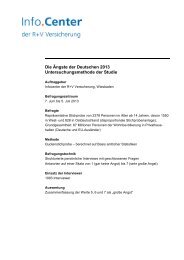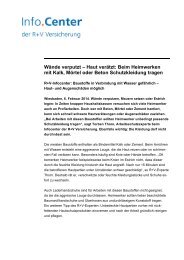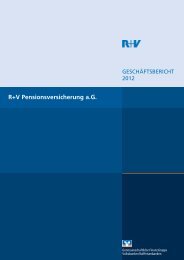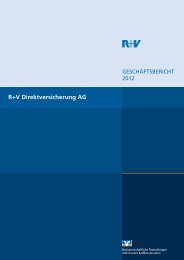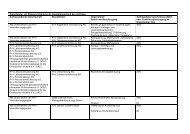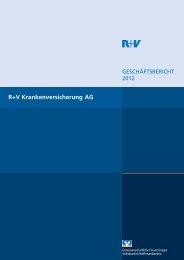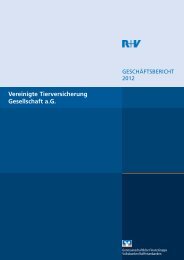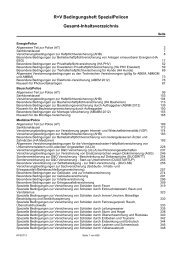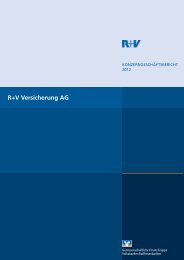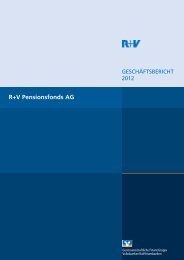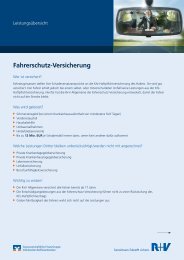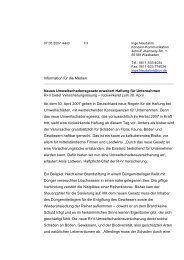Annual Report 2011 - R+V Versicherung
Annual Report 2011 - R+V Versicherung
Annual Report 2011 - R+V Versicherung
Create successful ePaper yourself
Turn your PDF publications into a flip-book with our unique Google optimized e-Paper software.
22<br />
Supplementary report / Risk report<br />
become effective for the first time for the 2012 annual result.<br />
The aim of being able to offset positive and negative tax results<br />
at parent company level in the context of an interlocking<br />
tax relationship will be achieved on the basis of this agreement.<br />
There were no further events of particular significance after<br />
the year end that need to be reported.<br />
Risk report<br />
Risk management process<br />
The core of the <strong>R+V</strong> <strong>Versicherung</strong> AG business model is the<br />
acceptance and management of risks. The risk management of<br />
<strong>R+V</strong> <strong>Versicherung</strong> AG is an integral part of corporate management<br />
and is embedded in the corporate strategy.<br />
It encompasses all systematic measures for recognising, evaluating<br />
and controlling risks. The main aim of the risk management<br />
process is to ensure solidity and security for policyholders<br />
and shareholders as well as the continuation of the company<br />
in the long term. Furthermore, with the help of the risk<br />
management process, risks that pose a danger to the existence<br />
of the company and other negative developments that could<br />
have significant effects on the assets, financial and earnings<br />
situation are to be recognised at an early stage and counter<br />
measures are to be initiated. A risk management process implemented<br />
in all <strong>R+V</strong> companies stipulates the rules to be observed<br />
when dealing with risks and forms the basis for a centralised<br />
early warning system. Shareholdings are also included<br />
in <strong>R+V</strong> <strong>Versicherung</strong> AG’s risk management.<br />
The principles of the <strong>R+V</strong> risk management system are based<br />
on the agreed <strong>R+V</strong> risk strategy that is to be updated annually.<br />
This is derived from the corporate strategy while taking account<br />
of the strategic four-year plan agreed at the spring<br />
meeting of the Board of Management. The control of risks is<br />
documented in the Group Risk Handbook with extensive presentations<br />
of methods, processes and responsibilities. A basic<br />
principle of the risk organisation is the separation of risk mon-<br />
itoring and risk responsibility. The role of building up those<br />
responsible for risk positions is separated, in personnel and<br />
organisational terms, from the independent risk controlling<br />
role.<br />
The identified risks are allocated to the following risk<br />
categories: technical risk, market risk, credit risk, liquidity<br />
risk, concentration risk, operational risk, strategic risk and<br />
reputation risk.<br />
Based on binding key performance indicators and thresholds,<br />
an updated index evaluation of all significant risks to <strong>R+V</strong> is<br />
carried out in a database quarterly. Measures are initiated if a<br />
certain index value is exceeded. In addition, a targeted survey<br />
of executives and staff guarantees that risks are recognised<br />
early.<br />
The identified risks are subsequently evaluated in a quarterly<br />
risk conference. The central risk reporting system ensures<br />
transparency in reporting. In the event of changes to risks<br />
which pose a danger to the existence of the company, reports<br />
to the member of the Board of Management responsible and to<br />
the Head of the Risk Conference are envisaged.<br />
Risk relevant corporate information is made available to the<br />
responsible supervisory committee at regular intervals.<br />
Impact on the company risk profile is also analysed and<br />
assessed when introducing new reinsurance products. Risk<br />
aspects are also taken into account when planning and carrying<br />
out projects. Larger projects and investments are regularly<br />
assessed by the investment or product commission, as well as<br />
by the finance and reinsurance committee. Special attention<br />
is paid here to results and any measures taken, as well as<br />
to meeting budgets. Any necessary course corrections are<br />
initiated immediately.<br />
<strong>R+V</strong> has a holistic business continuity management system<br />
supplemented by a central coordination role. A committee with<br />
the crisis managers responsible for IT, buildings and personnel<br />
provides support on specialist issues. It also networks emer-



